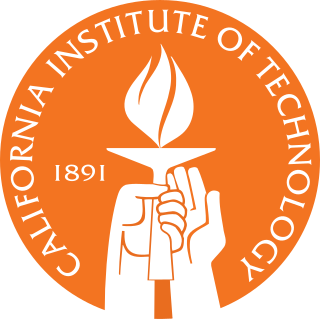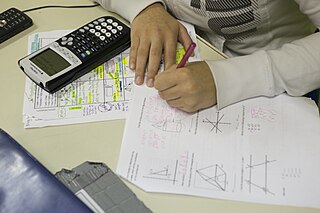
The California Institute of Technology (branded as Caltech) is a private research university in Pasadena, California. The university is responsible for many modern scientific advancements and is among a small group of institutes of technology in the United States that are strongly devoted to the instruction of pure and applied sciences. Due to its history of technological innovation, Caltech has been considered to be one of the world's most prestigious universities.

The University of Waterloo is a public research university with a main campus in Waterloo, Ontario, Canada. The main campus is on 404 hectares of land adjacent to uptown Waterloo and Waterloo Park. The university also operates three satellite campuses and four affiliated university colleges. The university offers academic programs administered by six faculties and thirteen faculty-based schools. Waterloo operates the largest post-secondary co-operative education program in the world, with over 20,000 undergraduate students enrolled in the university's co-op program. Waterloo is a member of the U15, a group of research-intensive universities in Canada.

Isadore Manuel Singer was an American mathematician. He was an Emeritus Institute Professor in the Department of Mathematics at the Massachusetts Institute of Technology and a Professor Emeritus of Mathematics at the University of California, Berkeley.
The William Lowell Putnam Mathematical Competition, often abbreviated to Putnam Competition, is an annual mathematics competition for undergraduate college students enrolled at institutions of higher learning in the United States and Canada. It awards a scholarship and cash prizes ranging from $250 to $2,500 for the top students and $5,000 to $25,000 for the top schools, plus one of the top five individual scorers is awarded a scholarship of up to $12,000 plus tuition at Harvard University, the top 100 individual scorers have their names mentioned in the American Mathematical Monthly, and the names and addresses of the top 500 contestants are mailed to all participating institutions. It is widely considered to be the most prestigious university-level mathematics competition in the world, and its difficulty is such that the median score is often zero or one despite being primarily attempted by students specializing in mathematics.

Elias Menachem Stein was an American mathematician who was a leading figure in the field of harmonic analysis. He was the Albert Baldwin Dod Professor of Mathematics, Emeritus, at Princeton University, where he was a faculty member from 1963 until his death in 2018.

University of Wisconsin–Platteville is a public university in Platteville, Wisconsin. Part of the University of Wisconsin System, it offers bachelor's and master's degrees. The university has three colleges that serve over 8,000 students on-campus and an additional 3,000 students through its five distance education programs.

The University of Washington Bothell is a public university in Bothell, Washington. It is a university in the University of Washington system founded in 1989. It is located just northwest of the junction of Interstate 405 and State Route 522, and shares a campus with Cascadia College.
The International Mathematics Competition (IMC) for University Students is an annual mathematics competition open to all undergraduate students of mathematics. Participating students are expected to be at most twenty three years of age at the time of the IMC. The IMC is primarily a competition for individuals, although most participating universities select and send one or more teams of students. The working language is English.
A Bachelor of Economics is an academic degree awarded to students who have completed undergraduate studies in economics. Specialized economics degrees are also offered as a "tagged" BA (Econ), BS (Econ) / BSc (Econ), BCom (Econ), and BSocSc (Econ), or variants such as the "Bachelor of Economic Science".
A math circle is an extracurricular activity intended to enrich students' understanding of mathematics. The concept of math circle came into being in the erstwhile USSR and Bulgaria, around 1907, with the very successful mission to "discover future mathematicians and scientists and to train them from the earlies possible age".
HMMT is a semiannual (biannual) high school mathematics competition that started in 1998. The Autumn (November) tournament is held annually at Harvard University in Cambridge, Massachusetts, and the Spring (February) tournament is held annually at MIT, also in Cambridge, Massachusetts, alternating between the campuses. The competition is organized and executed in a tightly-knit partnership between the corresponding student groups at Harvard and at MIT. From problem writing to logistics, the competition is handled primarily by undergraduate students at Harvard and MIT.
Evan Michael O'Dorney is an American mathematician who is a postdoctoral associate at Carnegie Mellon University. As a home-schooled high school student and college student, he won many contests in mathematics and other subjects, including the 2007 Scripps National Spelling Bee, 2011 Intel Science Talent Search, four International Math Olympiad medals, and three Putnam Fellowships. A 2013 report by the National Research Council called him "as famous for academic excellence as any student can be".
Math 55 is a two-semester freshman undergraduate mathematics course at Harvard University founded by Lynn Loomis and Shlomo Sternberg. The official titles of the course are Studies in Algebra and Group Theory and Studies in Real and Complex Analysis. Previously, the official title was Honors Advanced Calculus and Linear Algebra.
Gordon Frank Newell was an American scientist, known for his contributions to applied mathematics, in particular traffic flow analysis and queueing theory. Newell authored over one hundred articles and wrote several books. The Gordon–Newell theorem is named after him and his colleague William J. Gordon. Their algorithms helped form the basis of most modern automatically controlled and networked traffic-light control systems.

The University of Wisconsin–Madison is a public land-grant research university in Madison, Wisconsin, United States. Founded when Wisconsin achieved statehood in 1848, UW–Madison is the official state university of Wisconsin and the flagship campus of the University of Wisconsin System. It was the first public university established in Wisconsin and remains the oldest and largest public university in the state. UW–Madison became a land-grant institution in 1866. The 933-acre (378 ha) main campus, located on the shores of Lake Mendota, includes four National Historic Landmarks. The university also owns and operates the 1,200-acre (486 ha) University of Wisconsin–Madison Arboretum, located 4 miles (6.4 km) south of the main campus, which is also a National Historic Landmark.

Mathematics education in the United States varies considerably from one state to the next, and even within a single state. However, with the adoption of the Common Core Standards in most states and the District of Columbia beginning in 2010, mathematics content across the country has moved into closer agreement for each grade level. The SAT, a standardized university entrance exam, has been reformed to better reflect the contents of the Common Core. However, many students take alternatives to the traditional pathways, including accelerated tracks. As of 2023, twenty-seven states require students to pass three math courses before graduation from high school, while seventeen states and the District of Columbia require four. A typical sequence of secondary-school courses in mathematics reads: Pre-Algebra, Algebra I, Geometry, Algebra II, Pre-calculus, and Calculus or Statistics. However, some students enroll in integrated programs while many complete high school without passing Calculus or Statistics. At the other end, counselors at competitive public or private high schools usually encourage talented and ambitious students to take Calculus regardless of future plans in order to increase their chances of getting admitted to a prestigious university and their parents enroll them in enrichment programs in mathematics.
Alison Beth Miller is an American mathematician who was the first American female gold medalist at the International Mathematical Olympiad. She also holds the distinction of placing in the top 16 of the Putnam Competition four times, the last three of which were recognized by the Elizabeth Lowell Putnam award for outstanding performance by a woman on the contest.
Ruth Alexandra Britto-Pacumio is an American mathematical physicist whose research topics include black holes, Yang–Mills theory, and the theory of Feynman integrals; with Freddy Cachazo, Bo Feng, and Edward Witten she is one of the namesakes of the BCFW recursion relations for computing scattering amplitudes. She is an associate professor in mathematics and theoretical physics at Trinity College Dublin, and is also affiliated with the Institut de physique théorique - IPhT Saclay.










